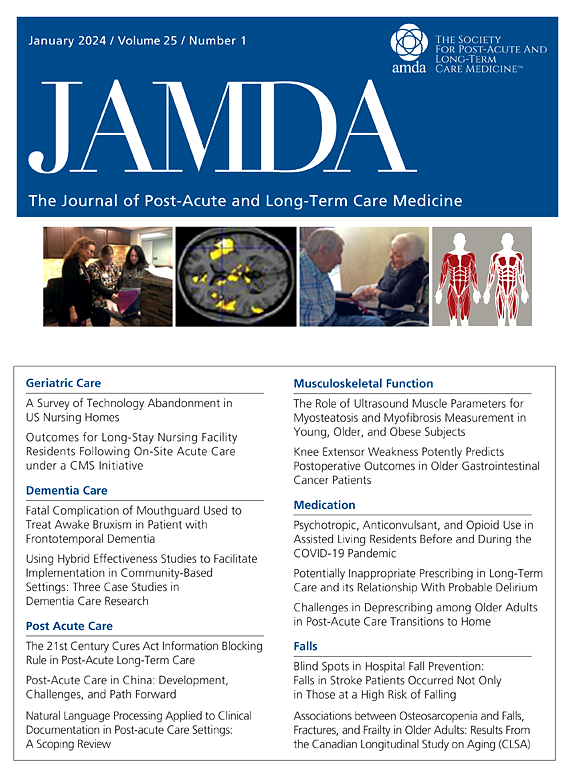影响退休村居民脆弱状况变化的因素。
IF 4.2
2区 医学
Q2 GERIATRICS & GERONTOLOGY
Journal of the American Medical Directors Association
Pub Date : 2025-06-04
DOI:10.1016/j.jamda.2025.105626
引用次数: 0
摘要
目的:居住在退休村(rv)(其他地方称为持续护理退休社区)的老年人被认为生活在一个相对老年人友好的环境中。许多房车都有医疗保健和家庭支持的设施和资源,以及体育活动和社会参与的机会。生活在这样的环境中可能会影响身体虚弱的变化。设计:纵向队列研究。环境和参与者:来自33辆房车的578名居民。方法:采用国际居民评估工具(Resident international Resident Assessment Instrument)编制脆弱性指数,基线收集村级数据(通过调查)。2.5年后,用国际居民评估工具对参与者进行了重新评估。采用多变量logistic回归分析与衰弱恶化或死亡相关的因素。结果:随访时,47名参与者死亡,478名参与者计算了进一步的衰弱指数。在整个队列中,289人(55.0%)在平均2.5年的时间内保持相同的虚弱状态,23人(4.4%)改善,166人(31.6%)虚弱状态恶化。基线时年龄0 ~ 90岁(优势比[OR], 3.34;95% ci, 1.61-6.93;P = .001),生活质量差/一般(OR, 2.94;95% ci, 1.35-6.40;P = .007),最近30天内长期感兴趣的社会活动参与情况(3天内比较:OR为1.99;95% ci, 1.06-3.71;P = .03),非营利组织拥有的村庄(OR, 1.71;95% ci, 1.06-2.77;P = .03)与虚弱状态恶化或死亡的几率较高相关。与过去12个月内没有看过牙医有显著的相关性(OR, 1.43;95% ci, 0.98-2.08;P = .07),敏感性分析有显著性(OR, 1.57;95% ci, 1.08-2.26;P = .02)。结论和意义:居住在假定的老年人友好社区的老年人,个人和rv水平的因素与衰弱或死亡的恶化有关,其中一些是可以改变的。需要进一步研究RV所有权模型之间的差异以及这种差异如何影响脆弱性。了解更广泛的社会和自然环境如何影响脆弱性,对于在社区一级设计预防脆弱性战略和创造对脆弱性友好的预防性环境至关重要。本文章由计算机程序翻译,如有差异,请以英文原文为准。
Factors Influencing Change in Frailty Status in Retirement Village Residents
Objectives
Older people residing in retirement villages (RVs) (elsewhere called continuing care retirement communities) are thought to live in a relatively age-friendly environment. Many RVs have facilities and resources for health care and home-based supports and opportunities for physical activity and social engagement. Living within such environments may influence changes in frailty.
Design
Longitudinal cohort study.
Setting and Participants
A total of 578 residents from 33 RVs.
Methods
Resident international Resident Assessment Instrument data, used to develop the frailty index, and village-level data (by survey) were collected at baseline. Participants were reassessed with the international Resident Assessment Instrument 2.5 years later. Analysis of factors associated with worsening frailty or death was performed with multivariable logistic regression.
Results
At follow-up, 47 participants had died, and a further frailty index was calculated in 478 participants. Within the entire cohort, 289 (55.0%) stayed within the same frailty category, 23 (4.4%) improved, and 166 (31.6%) worsened in frailty status during a mean of 2.5 years. Aged >90 years at baseline [odds ratio (OR), 3.34; 95% CI, 1.61-6.93; P = .001], poor/fair quality of life (OR, 2.94; 95% CI, 1.35-6.40; P = .007), participation in social activities of long-standing interest in the last 30 days (comparator within 3 days: OR, 1.99; 95% CI, 1.06-3.71; P = .03), and villages owned by not-for-profit organizations (OR, 1.71; 95% CI, 1.06-2.77; P = .03) were associated with higher odds of worsening frailty status or death. There was a borderline significant association with not visiting a dentist in the past 12 months (OR, 1.43; 95% CI, 0.98-2.08; P = .07), with significance found on sensitivity analysis (OR, 1.57; 95% CI, 1.08-2.26; P = .02).
Conclusions and Implications
In older adults residing in presumed age-friendly communities, individual and RV-level factors were associated with worsening frailty or death, some of which are modifiable. Further research addressing differences between RV ownership models and how this influences frailty is needed. Understanding how the wider social and physical environment influences frailty is essential for designing frailty prevention strategies at the neighborhood level and in the creation of frailty-friendly and preventative environments.
求助全文
通过发布文献求助,成功后即可免费获取论文全文。
去求助
来源期刊
CiteScore
11.10
自引率
6.60%
发文量
472
审稿时长
44 days
期刊介绍:
JAMDA, the official journal of AMDA - The Society for Post-Acute and Long-Term Care Medicine, is a leading peer-reviewed publication that offers practical information and research geared towards healthcare professionals in the post-acute and long-term care fields. It is also a valuable resource for policy-makers, organizational leaders, educators, and advocates.
The journal provides essential information for various healthcare professionals such as medical directors, attending physicians, nurses, consultant pharmacists, geriatric psychiatrists, nurse practitioners, physician assistants, physical and occupational therapists, social workers, and others involved in providing, overseeing, and promoting quality

 求助内容:
求助内容: 应助结果提醒方式:
应助结果提醒方式:


